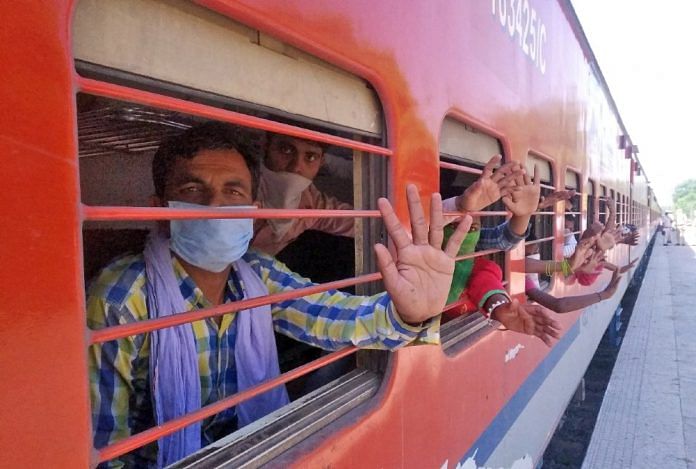New Delhi: Data being compiled by the central government on the state-wise recovery and fatality rates for Covid-19 is throwing up significantly different numbers across the country.
For example, while the recovery rate in Kerala is 94 per cent (as of 7 May), it is 9 per cent in Punjab. Similarly, while the recovery rate in Telangana is 62 per cent, it is 17 per cent in Maharashtra. The variation is just as stark for the case fatality rate (CFR), or the number of coronavirus patients dying.
However, experts told ThePrint that variations in these figures should not form the basis to assess a state’s performance since the pandemic hit different areas at different times. To compare Punjab as it grapples with its coronavirus peak to Kerala, which may have seen off its worst, would be inaccurate, they said.
According to data from the Union Health & Family Welfare ministry, which is being shared with states through limited-access Government of India websites, Rajasthan (55 per cent), Karnataka (52 per cent), Andhra Pradesh (43 per cent), and Haryana and Jammu & Kashmir (both 42 per cent) currently have among the highest recovery rates.
Those with the lowest recovery rates include West Bengal (19 per cent), Gujarat (24 per cent), Tamil Nadu (29 per cent), Delhi (32 per cent) and Madhya Pradesh (38 per cent).
The average recovery rate in India is 30 per cent.
The CFR is highest in West Bengal at 10 per cent (as of 7 May), followed by Madhya Pradesh and Gujarat, where it has been recorded at 6 per cent.
The CFR is 1 per cent for several other states and union territories like Delhi, Tamil Nadu, Jammu & Kashmir, Haryana, Bihar and Kerala.
There is no direct correlation between the number of cases and the recovery or the fatality rate, the data shows.
For example, West Bengal, with the highest CFR, has recorded 1,548 cases, while Delhi, with 5,980 cases, has a CFR of 1 per cent.
The average fatality rate for the country is 3 per cent.
ThePrint reached health ministry spokesperson Dr Manisha Verma, through WhatsApp and calls, for a response on why there are such variations, but there was no response until the time of publishing this report.
Also Read: R0 at 1.27 but experts say India yet to hit Covid peak, lockdown alone can’t end pandemic
Why the variations?
Sources in the government said while both the recovery rate and the CFR are important matrix, they can throw up “erroneous findings” upon comparison.
“See, if in a state like Kerala, the spike in cases happened much earlier, then their recovery rate will be higher than in a state like Punjab, where cases have just started coming up,” said a source in the central government.
“Similarly, even the fatality rate will depend on when the cases spiked in a particular state,” the official said.
An official in a state government who did not want to be identified said a better criterion to assess performance would be to get the ratio of deaths and recoveries in those states. “That will tell you the true picture,” the official added.
For example, in West Bengal, if the number of deaths is 151, and the number of recoveries is 296, the ratio of death to recovery would be 51.01 per cent, a worrisome figure.
For Bihar, on the other hand, while the recovery rate is low at 9 per cent, the ratio of deaths (28) to recoveries (149) is 18.79 per cent.
Dr Tanmay Mahapatra, an epidemiologist with CARE India, an NGO involved in public health, also said that comparing fatality or recovery rates of different states is a futile exercise.
“Different states are at different levels of the pandemic,” he said. “Different states imported the pandemic at different times, so they would naturally hit the three stages of the pandemic at different times… If at all we have to compare, we should compare the rate of recovery or fatality of states from their first reported case,” he added.
“These indicators are just numbers otherwise,” he said. “Ideally, state-wise pandemic response models should be studied and it should be established how long each state responded after its first case, used the lockdown, etc.”
Also Read: India’s Covid curve hasn’t ‘relatively flattened’. I compared govt data with other nations




As you have mentioned if it is better to consider the ratio between fatality and recovery numbers, you can see the better values in kerala. 4 (including 1 in mahe) / 485. It gives around 0.83
As you have mentioned if it is better to consider the ratio between fatality and recovery numbers, you can see the better values in kerala. 4 (including 1 in mahe) / 485. It gives around 0.82. Why don’t you include that one in the article?
You (famous Indian medias centered in North)still can’t agree kerala is the best and we don’t need your affirmation because the world knows which state is the best?